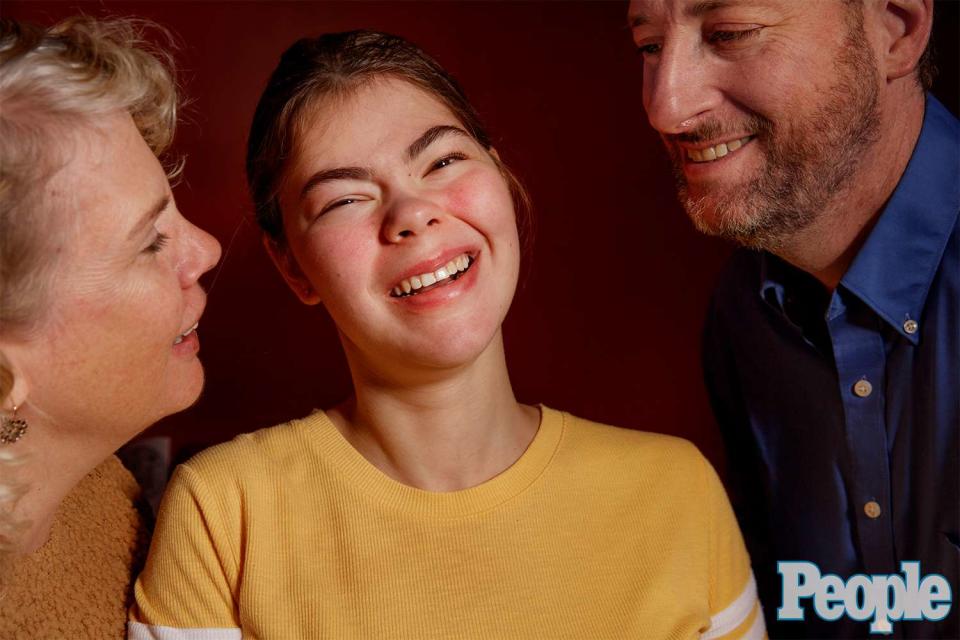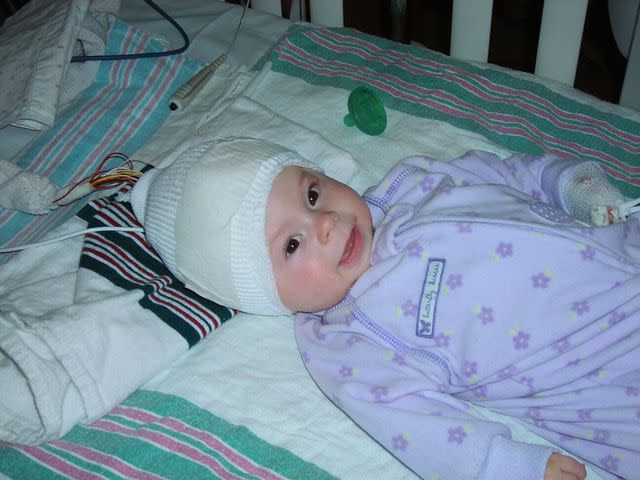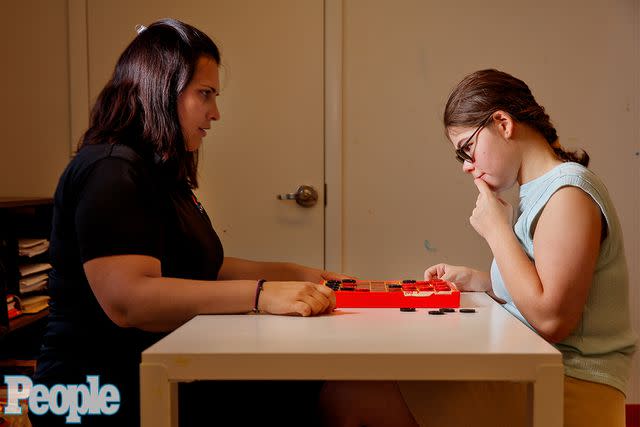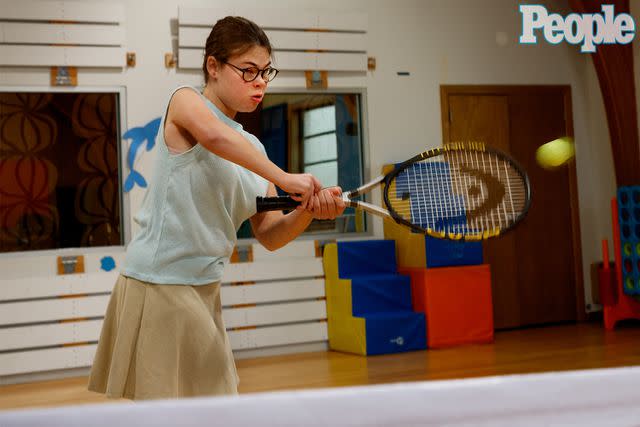Why These Parents Made the Agonizing Decision to Have Half Their Child's Brain Removed (Exclusive)
Mora Leeb, now 16, was 9 months old when she underwent a hemispherectomy. Her doctors explain why such a drastic operation was her best chance for a full life

Elinor Carucci
Mora Leeb with her parents Ann and Seth, photographed for PEOPLE in October 2023.When Ann and Seth Leeb’s daughter Mora was just four months old in January 2008, she began experiencing seizures. Barely noticeable at first, they soon numbered hundreds a day. Mora, they learned, had suffered a stroke in utero, which had destroyed most of the left hemisphere of her brain and triggered catastrophic epilepsy.
Medication proved no help, and the South Orange, N.J., couple were faced with what seemed like a terrifying decision: Mora’s best chance for stopping the seizures, a doctor told them, was a hemispherectomy— removing the damaged part of her brain. “We were stunned,” says Ann Leeb. “Shocked.”
Related: Teen Had Half Her Brain Removed as a Baby — Now She’s Living a ‘Glass Half-Full Life’ (Exclusive)
It’s a reaction that Monika Jones knows well. As the founder and executive director of the Pediatric Epilepsy Surgery Alliance, she’s talked to many families in the same situation. “We hear parents say, ‘I can’t do that to my child,’” she says. “The journey to epilepsy surgery is a very frightening one.”
Part of the mission of the Alliance is to help parents navigate that journey — and understand how vital surgery can be. “We want to start the conversation. Epilepsy surgery is not a last resort. It can save lives.”
Ann and Seth Leeb got over their initial shock as they came to understand the consequences of not proceeding with surgery. “A doctor explained that Mora’s brain had taken a pounding,” Ann says. And the doctor told them that the seizures could begin to affect the healthy side of her brain — essentially the “good side” could learn to have seizures too.

Courtesy Leeb Family
Mora Leeb in March 2008 at six months old with brain monitoring equipment.About two thirds of patients with epilepsy will respond to medication. For the one-third with drug-resistant epilepsy, if the seizure activity is connected to one area of the brain, as was the case with Mora, surgery may be the best option. “When a baby's having seizures that are that frequent, the brain is not doing any of its normal functions,” says Dr. Prakash Kotagal, a pediatric epileptologist at Cleveland Clinic who has treated Mora. “Their development not only stagnates, but actually regresses. Our goal is to stop the seizures as quickly as you can. If medications will work, that's wonderful. If not, then we look for other options such as surgery.”
Time, however, is of the essence in cases like Mora’s. “If you stop the damaged hemisphere from seizing, you allow the good hemisphere to begin to develop, and patients are able to be at the best cognitively that they can be,” says Dr. William Bingaman, a neurosurgeon and head of epilepsy surgery at the Cleveland Clinic, who performed Mora’s surgery in 2008 and who does up to 40 hemispherectomies each year. (About 150 are performed in the U.S. annually.)
Jones knows how dangerous infantile spasms like Mora’s can be — her own son experienced seizures as an infant. “They are very dangerous type of seizures that can have extremely detrimental effects,” says Jones, whose son went on to have a hemispherectomy. “If you have an infant having infantile spasms, you really need to get to surgery as soon as you know that they're drug resistant. It’s important to know what a lifetime of drug-resistant seizures will do to a child. They might stop talking. They might stop walking. They might have organ damage or organ failure. They might die.”
The earlier in life a patient undergoes a hemispherectomy, the better. “The younger they are when they have the surgery, the better the chance for a good recovery,” says Dr. Kotagal, who says while the operation can be done at any stage in life, most are done on infants or toddlers. “The opposite hemisphere is able to assume many of the functions [normally performed by the other hemisphere]. That's what we call neuronal plasticity.”
Adds Jones: “There is tremendous potential of the healthy part of the brain to reorganize itself.”
Seth and Ann Leeb were sure that despite their fears, surgery was their answer. “My husband and I were a team on this,” Ann says. “This was our child, and this is what needed to get done. Seth and I were convinced that the sooner we did this, the sooner Mora would have the most normal development possible for Mora.”

Elinor Carucci
Mora Leeb playing checkers with her occupational therapist Alexandra Clayton at Intensive Therapeutics in New Jersey in October 2023.What that development would look like was an unknown, but outcomes after hemispherectomies are often surprisingly good, according to Dr. Bingaman, who says that the vast majority of patients are seizure-free after the procedure.
Related: Woman Who Had Half Her Brain Removed Defies the Odds, Gets a Master's Degree
“One of the questions people ask is, "If you take a hemisphere out, what happens to people?’ Most of the time, nothing happens from a functional standpoint because they've had an already damaged hemisphere,” he says. “Almost all of the people after hemispherectomy, even adults, almost all of them walk. They usually walk with a little bit of a different gait, a little bit of a limp.” Their peripheral vision can be affected, along with cognition, attention and memory, "but if you stop the seizures, their personality develops and can be normal. We've had kids go on and get through college, and get married, and have families. And it's amazing how it works. We can't explain all of it.”
Mora, who is now 16, had her hemispherectomy in June 2008, when she was nine months old. Dr. Bingaman and his team performed what is known as a “functional” hemispherectomy, disconnecting her damaged left hemisphere from her right and removing tissue from the left side.

Elinor Carucci
Mora Leeb playing tennis in October 2023.After the operation, “it was like a restart,” says Ann. Mora was like a newborn again. In time, she was able to reach her milestones — smiling, rolling over— for the second time, and that progression meant hope. “Mora was reborn for all the possibilities,” Ann says. She learned to sit up at 18 months, walk at 23 months and was speaking in full sentences by the age of 6 ½.
In 2018, Mora began experiencing seizures again and her team at Cleveland Clinic recommended a second surgery — this time an anatomical hemispherectomy, completely removing the remaining tissue in the left hemisphere in hopes of stopping the seizures. But she’s continued to learn and grow — she’s now in ninth grade and is reading. She can play tennis and is studying algebra.
Related: Camila Coelho Says Being a Mom Is 'Surreal' as Her Epilepsy Gave Her 'Doubts' of Starting a Family
Jones points out that not every epilepsy surgery “means taking out half your brain. There's a whole menu of options out there.” And the patient outcomes are a broad range as well. In addition to supporting families like the Leebs with practical guidance and emotional support, her organization is compiling an epilepsy surgery registry so other parents, as well as researchers, can get a better understanding of what to expect post-surgery.
In Dr. Bingaman’s experience, “these kids are happy, smiling kids — and I think Mora just brings that all to mind.”

Elinor Carucci
Mora Leeb photographed for PEOPLE, October 2023.For more People news, make sure to sign up for our newsletter!
Read the original article on People.

